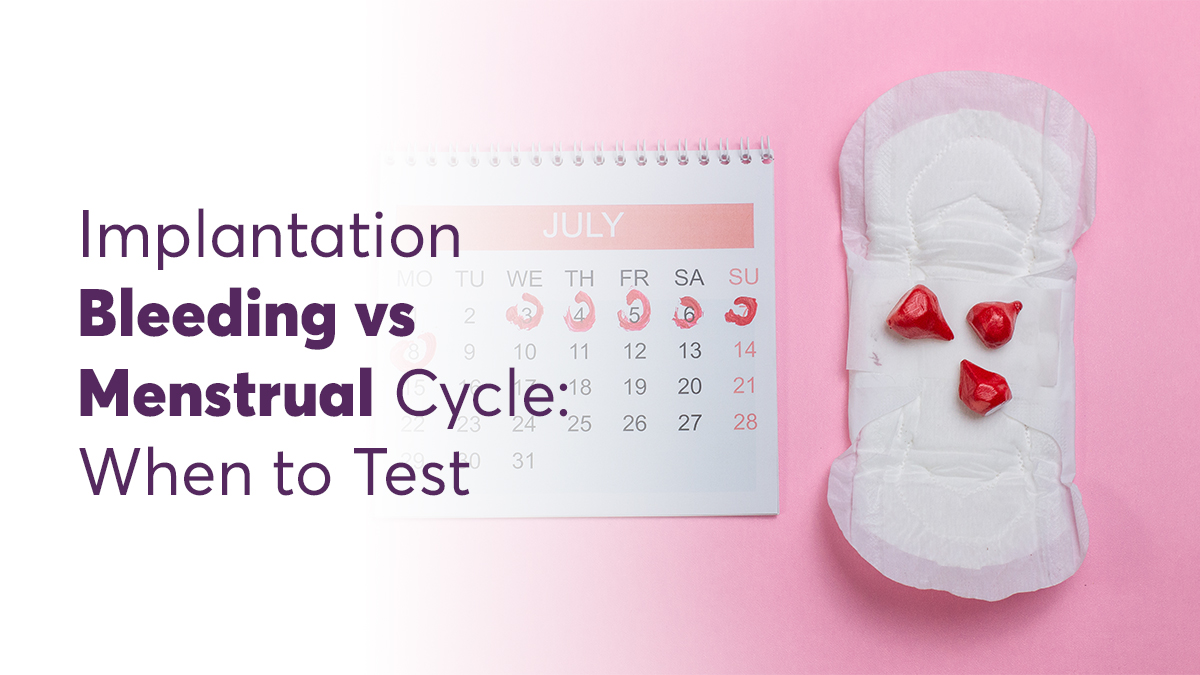
Implantation Bleeding vs. Menstrual Cycle: When to Test

Have you ever found yourself in that confusing moment where you are not sure if what you are seeing is the beginning of your period or even more special? For women who are trying to have babies, being able to tell the similarity between implantation bleeding and menstrual bleeding can be very important. The two have very subtle differences that can offer very important information about your reproductive health as well as a likely pregnancy. You can avoid the emotional roller coaster of uncertainty by understanding these signs and knowing when to take a pregnancy test. Read through this detailed article to learn about implantation bleeding vs. menstrual bleeding.
What is Implantation Bleeding?
Implantation bleeding is slight bleeding that happens when an egg, after being fertilized, latches onto your womb’s lining. This can cause a bit of bleeding in the beginning as the embryo burrows into your endometrial layer.
When Does Implantation Bleeding Normally Happen?
Implantation bleeding typically takes place from 6 – 12 days following ovulation. These would be days within which the egg should have been fertilized and attached to the uterine wall. Normally, it occurs about a week before your next expected menstrual period starts as a woman.
How to Recognize Bleeding After Implantation
Colour: Implantation bleeding is often light pink or brown in colour.
Flow: Implantation bleeding is characterized by light flow, often just a few spots and not enough to fill a pad or tampon.
Duration: Generally, this kind of bleeding lasts for a few hours to some days.
Symptoms: Mild cramps may be felt during implantation bleeding but they are usually less severe. Also, there are no blood clots in it.
Understanding the Menstrual Cycle
The womb sheds its lining when the woman is not pregnant. This is menstrual bleeding. It’s just one part of the monthly cycle that gets the body ready for the chance of a pregnancy.
Phases of Menstrual Cycle
Phase of Follicular: This phase begins on the first day of the period and continues till ovulation. An egg gets ready in the body for departure, and the uterine lining starts to grow thicker.
Ovulation: This is the release of a mature egg from the ovary, occurring around the midpoint of the cycle.
Luteal Phase: Once an egg is released, the womb’s lining gets thicker to prepare for a possible pregnancy. If there isn’t a fertilized egg, hormone levels drop. This triggers the menstrual period to start.
Quality of Menstrual Bleeding
Colour: Menstrual blood can range from bright red to dark brown, often changing in shade throughout the period.
Flow: The flow during menstruation is generally heavier, especially in the first few days, and decreases over the course of the period.
Duration: A typical menstrual period lasts between 3 to 7 days.
Symptoms: Menstrual bleeding is often accompanied by more intense cramping, the presence of blood clots, and premenstrual syndrome (PMS) symptoms like bloating, mood swings, and breast tenderness.
Differences between Implantation Bleeding and Menstrual Bleeding
Factors |
Implantation Bleeding |
Menstrual Bleeding |
| Timing | Occurs around 6-12 days after ovulation. | Begins about 14 days after ovulation if pregnancy has not occurred. |
| Flow and Duration | Light spotting for a short time period | Heavy flow across a longer time frame |
| Associated Symptoms | Light Cramping, No PMS Symptoms Present | Severe Cramping, Accompanied With PMS Symptoms |
When Should You Take A Pregnancy Test After Implantation?
- Best Time: Wait until your period is due or a few days afterwards for the most accurate results. Implantation bleeding typically takes place before the anticipated menstruation, so testing too early could yield false negatives.
- Early Testing: If you want to test earlier, then use a pregnancy kit designed for early detection. Some of these tests can detect hormones of pregnancy a few days prior to a missed period.
- Repeat Test: In case the first test comes negative, but your period does not start, try testing again after couple more days. This is because hormone levels may vary and testing a few days later might show positive results.
Tips to Accurately Test for Pregnancy
- Morning Test: To obtain the highest concentration of hCG (human chorionic gonadotropin), use the first urine of the morning. This should make the test more accurate, especially during the early days of pregnancy.
- Read the Instructions: Follow the instructions that come with the pregnancy test carefully. There are specific steps and timing requirements for each test that must be followed to obtain an accurate result.
- Consult a Doctor: If you have irregular cycles or are experiencing unusual symptoms, it is recommended that you consult a doctor. A healthcare provider can offer more comprehensive testing and guidance.
Conclusion
Knowing how to tell apart implantation spotting and regular period can help women understand and handle the initial phase of pregnancy with ease and clarity.


fill up the form to get a
Free Consultation
Avail 0% interest on EMI
All Procedures | No Upper Limit
Frequently Asked Questions
Does implantation bleeding smell like a period?
Can you bleed like a period in early pregnancy?
Is implantation bleeding watery?
How we reviewed this article:
- Current Version
- August 1, 2024 by Oasis Fertility
- June 26, 2024 by Oasis Fertility





